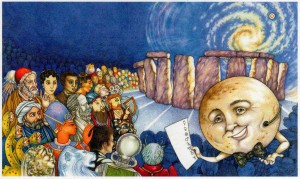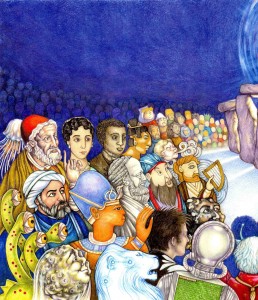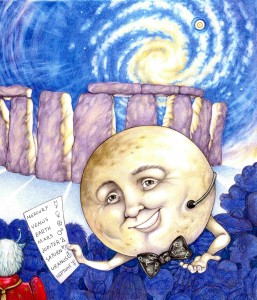As i always say, to anyone who will listen, there is always more going on in an illustration than you might realize, but Meet the Planets takes that concept to a whole new level of multi-layered obsessive/compulsive craziness. Bottom line – i had so much fun researching the book, and found such a wealth of unexpected information and fascinating links and connections, i had to find a way to squish it all into the book. The down side to that compulsion, however, is – i’m the only one who knows why all this stuff is here. In fact i recently discovered that even close friends, who know me and know the story, were unaware of all the miscellaneous identifications and meanings (and they all got autographed copies of the book, with the link to the section on my web site that explains everything). Clearly something needed to be done. Besides – i couldn’t resist an opportunity to go back and explore it all – again. So grab a cold beverage, get comfy, and let’s meet everyone, and everything, in Meet the Planets. Starting with the very first spread – the Introduction.
Being the Favorite Planet Competition there obviously needs to be an audience. Originally i planned to just do the crowd in shadow and silhouette, then i thought perhaps i’d tuck in a few faces of people i knew, but after i started finding all this wonderful information ad all these amazing people (and things) from history and science i realized i had the perfect audience.
NOTE: In terms of the illustration design, i decided i would represent everyone in the technique or medium in which i found them in my research – whether it be a sculpture or a fresco or a lithograph or an old photograph – so that explains the wide range of styles (not to mention made it a blast to draw!!!!)..
Starting at the top and working left to right:
JELLYFISH: one of the 1st primitive animals to appear on Earth 600 million years ago (originally i had a dinosaur here, but wound up using him later on. Besides, i wanted to go back even farther into the primordial stew for this first page).
PTOLEMY: (100 – 178) Alexandrian Greek philosopher & astronomer. He thought the Earth was the center of the universe (and i suspect some folks still do).
HYPATIA: (415) Alexandria female astronomer, astrologer & mathematician. Her portrait is based on a fresco (to my shame i initially forgot her, even tho she was mentioned often in my research. Then i remembered how much Carl Sagan admired her – and i LOVE Carl Sagan – so quickly put her in her rightful place).
BENJAMIN BANNEKER: (1731 – 1806) 1st African American astronomer, mathematician & scientist. He calculated the astronomical tables and predicted an eclipse.
THE MAYANS: Represented here because they built an observatory in 1000 (not to mention created that cool calendar).
BACKGROUND CROWD: Crowds are always something of a pain to do but this one was easier because it was inspired by a fun reference – a 1490 engraving of the Ptolemaic Universe (and yes, for those of sharp eye, that is a certain Jedi Master sitting there as well).
ABD AL-RAHMAN AL-SUFI: (964) Persian astronomer, he compiled “The Book of Fixed Stars“. Also, according to some historians, Persian astronomers invented the astrolabe in 4001.
RAMESES THE GREAT: (1,200 BC) The earliest known almanac was created during the reign of this Egyptian pharaoh.
THALES: (585 BC) Greek astronomer who also predicted the solar eclipse.
CHINESE ASTRONOMERS: Built observatories in 2,300BC and made the earliest known observation of a comet in 2,296 BC.
WIND CHERUB: A popular way of depicting wind in Western art and maps.
NEOLITHIC GRAVESTONE/BURIAL CHAMBER (the swirly rock): Newgrange, Ireland (3,200 BC) is aligned so that on the day of the Winter Solstice sunlight illuminates the rear wall of the chamber making it one of the first solar observatories.
TALIESiN (in front of the Newgrange gravestone): was a Celtic poet (done here in the style of the Medieval “Book of Kells“) representing ancient Celtic mythology (and because Taliesin was mentioned in a poem about the cosmos and the “music of the spheres” and because he just fascinates me).
4-EYED ALIEN: Just for fun.
COMET: 65 million years ago a comet or asteroid struck the northern tip of the Yucatan Peninsula causing the end of the dinosaurs and paving the way for mammals to flourish (and eventually illustrate books about the planets).
LEO: A constellation, Zodiac icon, and solar/Sun sign.
NERDY, SCIENCE GEEK: A person obsessively enthusiastic about science. And Time.
METEORITE FRAGMENT: No story really, i just needed to fill the space.
ROBOT/PRINTED CIRCUIT BOARD: Because where would we be without ’em?
PLUTO: Our Master of Ceremonies (i love that John got him into the book). I discovered all the planets have a symbol so that is what is on the paper in Pluto’s hand (his symbol is on his tie). Each symbol is also hidden on the page of its respective planet throughout the book – if you want to go on a little hunt.
STONEHENGE: (2,900 – 1,600 BC) Being a ceremony i figured we needed a stage set and instantly thought of Stonehenge. There were other ancient observatories i could have used, but some were pretty obscure, and others – like the Pyramids – were more closely aligned with tombs than space. Stonehenge is an ancient megalithic monument easily recognizable no matter what the age, and wonderfully mysterious and enigmatic. It’s placement suggests astronomical connections and was possibly used to predict solar and lunar eclipses, making it the 1st astronomical calculator. Not to mention – a great stage set.
SPIRAL GALAXY: I should clarify – OUR spiral galaxy. Spiraling out from the center, left to right, we have the Centaurus Arm, the Sagittarius Arm, the Orion Arm, the Perseus Arm, and the Cygnus Arm.
And that dot within a circle, located in the Orion Arm, is the sign for the Sun – OUR SUN.
Now as the lights dim and the audience grows quiet, the first notes of the Music of the Spheres begins to play. First up – the Inner Planets.


